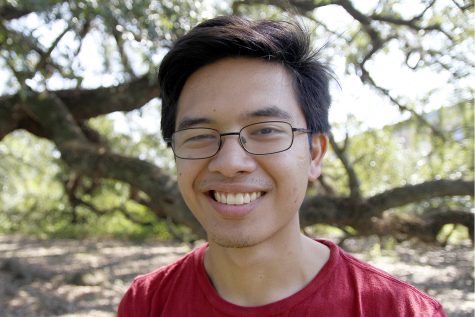
Associate Professor of Physics Dr. Rhett Allain was recently the featured speaker for the North Carolina Region 8 Western Regional Science and Engineering Fair at Western Carolina University. Zachary Araki/The Lion's Roar
Associate Professor of Physics Dr. Rhett Allain uses science to analyze real life and the superhero movies he enjoys.
As the featured speaker for the North Carolina Region 8 Western Regional Science and Engineering Fair at Western Carolina University, Allain talked about superhero science.
“The first one was for third to fifth graders, and that’s not usually the audience I talk to because you really have to break down topics, no math or anything like that,” said Allain. “But I think it went well talking about superheroes and science. They pretty much like that stuff. It was a big crowd too, probably 100 to 150 students. The next day was high school students, and I think they understood a little more what I was talking about, especially since they were in the science fair anyway.”
Allain explained why science fairs may not be the best avenue for getting kids interested in science.
“They’re required to have this format of: my hypothesis, my materials, in this very cookie cutter way, and it doesn’t reflect the way we actually do science,” said Allain. “In fact even then, the judging, making it a competition, tt feels as though the way they do the judging, there’s a level that doesn’t always match the science. Some people focus on presentation. Some people focus on materials and so forth. I don’t think it should be a competition.”
Allain suggested maker faires as a better alternative.
“It’s not a competition,” said Allain. “It’s just people sharing ideas about what they made and how they made it and stuff like that. It’s science-based. It’s not necessarily just science.”
Allain works freelance for the magazine Wired where he makes videos and articles such as “There’s No One Way to Explain How Flying Works.” He joined Wired in 2008. Occasionally, he also talks about the science in superhero movies as with the article “The Shrinking Building in Ant-Man and The Wasp Would Cause Massive Problems.”
“In the fall was the first time I’d been to Wired and met real people that worked at Wired,” said Allain. “That was really weird, especially since it’s a younger crowd there, so most of the people there hadn’t been there since 2010. I was like the old person, and it was interesting to make that connection between real people and people that you work with all the time online. It was fun.”
Allain got into superheroes from reading comic books that were “immersive” and “a way to be in a different place.”
“If you had to go back in time, 1984, I was a teenager,” said Allain. “Worldwide web, there’s no worldwide web. Movies, they weren’t the kind of movies that we have now. I liked reading. I read a lot of books, and to fill in the gaps between books was comic books. I would go to the comic book store every Friday, and have my friends, we would talk about comic books. It’s what we did.”
Allain discussed the difference between analyzing and critiquing a movie.
“There are people that will say, ‘Oh, look, Spider-Man couldn’t do this, and that’s wrong, and it’s bad,’ and I don’t do that,” said Allain. “I think the number one job of a movie is to tell a story, and if they have to change the laws of physics to do that, do it because I enjoy the story. And I may point out that it’s not correct, but it’s really just to talk about the physics. I’m not gonna say, ‘Oh, this movie sucks.’”


